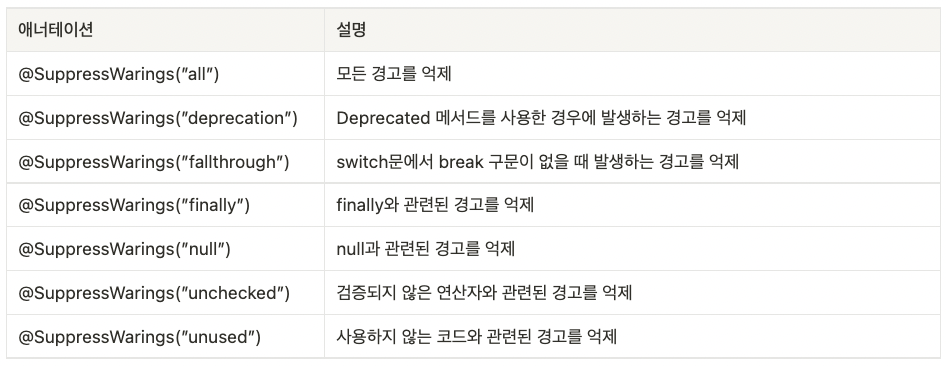[codestates] 어노테이션, 람다, 스트림
어노테이션
어노테이션은 소스 코드가 컴파일되거나 실행될 때 컴파일러 및 다른 프로그램에게 필요한 정보를 전달해 주는 문법 요소입니다.
JDK에서 기본적으로 제공하는 애너테이션은 아래의 두 가지로 구분됩니다.
- 표준 애너테이션 : JDK에 내장된 일반적인 애너테이션입니다.
- 메타 애너테이션 : 다른 애너테이션을 정의할 때 사용하는 애너테이션입니다.
표준 애너테이션은 앞서 살펴본 @Override와 같이 다른 문법 요소에 붙여서 사용하는 일반적인 애너테이션을 의미하며, 메타 애너테이션은 애너테이션을 직접 정의해서 사용할 때 사용하는 애너테이션입니다.
표준 애너테이션
@Override
@Override는 메서드 앞에만 붙일 수 있는 애너테이션으로, 선언한 메서드가 상위 클래스의 메서드를 오버라이딩하거나 추상 메서드를 구현하는 메서드라는 것을 컴파일러에게 알려주는 역할을 수행합니다.
@Deprecated
@Deprecated는 기존에 사용하던 기술이 다른 기술로 대체되어 기존 기술을 적용한 코드를 더 이상 사용하지 않도록 유도하는 경우에 사용합니다.
@SuppressWarnings
@SuppressWarnings 어노테이션은 컴파일 경고 메시지가 나타나지 않도록 합니다. 아래와 같이 @SuppressWarnings 뒤에 괄호를 붙이고 그 안에 억제하고자 하는 경고메시지를 지정해 줄 수 있습니다.

@FunctionalInterface
@FunctionalInterface 어노테이션은 함수형 인터페이스를 선언할 때, 컴파일러가 함수형 인터페이스의 선언이 바르게 선언되었는지 확인하도록 합니다. 만약 바르게 선언되지 않은 경우, 에러를 발생시킵니다.
메타 어노테이션
메타 어노테이션(meta-annotation)은 어노테이션정의하는 데에 사용되는 어노테이션으로, 어노테이션적용 대상 및 유지 기간을 지정하는 데에 사용됩니다.
@Target
@Target 어노테이션은 이름 그대로 어노테이션적용할 “대상”을 지정하는 데 사용됩니다. 아래와 같이 @Target 어노테이션을 사용하여 지정할 수 있는 대상의 타입이 있습니다.
| 대상 타입 | 적용 범위 |
|---|---|
| ANNOTATION_TYPE | 애너테이션 |
| CONSTRUCTOR | 생성자 |
| FIELD | 필드(멤버변수, 열거형 상수) |
| LOCAL_VARIABLE | 지역변수 |
| METHOD | 메서드 |
| PACKAGE | 패키지 |
| PARAMETER | 매개변수 |
| TYPE | 타입(클래스, 인터페이스, 열거형) |
| TYPE_PARAMETER | 타입 매개변수 |
| TYPE_USE | 타입이 사용되는 모든 대상 |
예를 들어 @Target(Element.Method) 로 하면 메서드에 적용되는 어노테이션입니다.
@Documented
@Documented 어노테이션은 어노테이션에 대한 정보가 javadoc으로 작성한 문서에 포함되도록 하는 어노테이션 설정입니다.
자바에서 제공하는 표준 어노테이션과 메타 어노테이션 중 @Override와 @SuppressWarnings를 제외하고는 모두 @Documented가 적용되어 있습니다.
@Inherited
@Inherited 어노테이션은 이름에서도 알 수 있듯이 하위 클래스가 어노테이션을 상속받도록 합니다. @Inherited 어노테이션을 상위 클래스에 붙이면, 하위 클래스도 상위 클래스에 붙은 어노테이션들이 동일하게 적용됩니다.
@Inherited // @SuperAnnotation이 하위 클래스까지 적용
@interface SuperAnnotation{ }
@SuperAnnotation
class Super { }
class Sub extends Super{ } // Sub에 애너테이션이 붙은 것으로 인식
@Retention
@Retention 어노테이션도 이름 그대로 특정 어노테이션의 지속 시간을 결정하는 데 사용합니다. 어노테이션과 관련한 유지 정책(retention policy)의 종류에는 다음의 세 가지가 있습니다.
| 유지 정책 | 설명 |
|---|---|
| SOURCE | 소스 파일에 존재, 클래스파일에는 존재하지 않음 |
| CLASS | 클래스 파일에 존재, 실행 시에 사용 불가, 기본값 |
| RUNTIME | 클래스 파일에 존재, 실행 시에 사용가능 |
@override 를 보겠습니다.
@Target(ElementType.METHOD)
@Retention(RetentionPolicy.SOURCE)
//오버라이딩이 제대로 되었는지 컴파일러가 확인하는 용도
//클래스 파일에 남길 필요 없이 컴파일 시에만 확인하고 사라짐
public @interface Override(){ }
위의 예제에서 Override 어테이션은 컴파일러가 사용하면 끝나기 때문에, 실행 시에는 더 이상 사용되지 않음을 의미합니다.
@Repeatable
@Repeatable 어노테이션은 어노테이션을 여러 번 붙일 수 있도록 허용한다는 의미가 있습니다.
사용자 타입의 어노테이션Work를 정의하고, @Repeatable 어노테이션을 사용하여 이것을 여러 번 사용할 수 있도록 하였습니다.
@Repeatable(Works.class) // Work 애너테이션을 여러 번 반복해서 쓸 수 있게 한다.
@interface Work{
String value();
}
이제 아래와 같이 Work 어노테이션을 여러 번 사용할 수 있습니다.
@Work("코드 업데이트")
@Work("메서드 오버라이딩")
class Main{
... 생략 ...
}
@Repeatable 어노테이션은 일반적인 어노테이션과 달리 같은 이름의 어노테이션이 여러 번 적용될 수 있기 때문에, 이 어노테이션들을 하나로 묶어주는 어노테이션도 별도로 작성해야 합니다. 아래와 같습니다.
@interface Works { // 여러 개의 Work애너테이션을 담을 컨테이너 애너테이션 Works
Work[] value();
}
@Repeatable(Works.class) // 컨테이너 애너테이션 지정
@interface Work {
String value();
}
lambda
람다 함수는 다음과 같이 메서드 타입, 이름을 생략할 수 있습니다. 따라서 람다함수를 종종 이름이 없는 함수, 즉 익명 함수(anonymous function)라 부르기도 합니다.
다음과 같이 사용할 수 있습니다.
int sum(int num1, int num2) {
return num1 + num2;
}
//축약 1
(int num1, int num2) -> { // 반환타입과 메서드명 제거 + 화살표 추가
return num1 + num2;
}
//실행문이 1개 일 때 대괄호 축약 가능
(int num1, int num2) -> num1 + num2
//매개변수 타입을 함수형 인터페이스를 통해 유추할 수 있는 경우, 매개변수의 타입을 생략
(num1, num2) -> num1 + num2
함수형 인터페이스
람다식은 이름이 없는 익명 객체입니다. 익명 객체는 익명 클래스를 통해 만들 수 있는데, 익명 클래스란 객체의 선언과 생성을 동시에 하여 오직 하나의 객체를 생성하고, 단 한 번만 사용되는 일회용 클래스입니다.
이러한 익명 클래스를 만들어주기 위해 자바의 함수형 인터페이스(Functional Interface) 를 사용합니다.
다음과 같습니다.
@FunctionalInterface
public interface MyFunctionalInterface {
int accept(int x, int y);
}
public class MyFunctionalInterfaceExample {
public static void main(String[] args) throws Exception {
MyFunctionalInterface example;
example = (x, y) -> {
int result = x + y;
return result;
};
int result1 = example.accept(2, 5);
System.out.println(result1);
example = (x, y) -> { return x + y; };
int result2 = example.accept(2, 5);
System.out.println(result2);
example = (x, y) -> x + y;
//return문만 있으면, 중괄호 {}와 return문 생략 가능
int result3 = example.accept(2, 5);
System.out.println(result3);
example = (x, y) -> sum(x, y);
//return문만 있으면, 중괄호 {}와 return문 생략 가능
int result4 = example.accept(2, 5);
System.out.println(result4);
}
public static int sum(int x, int y){
return x + y;
}
}
/*
출력값
7
7
7
7
*/
메서드 레퍼런스
메서드 참조는 람다식에서 불필요한 매개변수를 제거할 때 주로 사용합니다. 다음과 같이 사용할 수 있습니다.
(left, right) -> Math.max(left, right)
// 클래스이름::메서드이름
Math :: max // 메서드 참조
정적 메서드와 인스턴스 메서드 참조
클래스 :: 메서드 : 정적 메서드를 참조할 때는 클래스 이름 뒤에 :: 기호를 붙이고 정적 메서드 이름을 기술하면 됩니다.
참조 변수 :: 메서드 : 인스턴스 메서드의 경우에는 먼저 객체를 생성한 다음 참조 변수 뒤에 ::기호를 붙이고 인스턴스 메서드 이름을 기술하면 됩니다.
생성자 참조
메서드 참조는 생성자 참조도 포함합니다. 생성자를 참조한다는 것은 객체 생성을 의미합니다. 단순히 메서드 호출로 구성된 람다식을 메서드 참조로 대치할 수 있듯이, 단순히 객체를 생성하고 리턴하도록 구성된 람다식은 생성자 참조로 대치할 수 있습니다.
(a,b) -> new 클래스(a,b)
//생성자 참조 문법
클래스 :: new
스트림
스트림(Stream) 은 배열 및 컬렉션의 저장 요소를 하나씩 참조해서 람다식으로 처리할 수 있도록 하는 반복자입니다.
다음과 같은 특징을 가집니다.
- 스트림 처리 과정은 생성, 중간 연산, 최종 연산 세 단계의 파이프라인으로 구성될 수 있습니다.
- 스트림은 원본 데이터 소스를 변경하지 않습니다(read-only).
- 스트림은 일회용입니다(onetime-only).
- 스트림은 내부 반복자입니다.
스트림 생성
배열 스트림 생성
-
Arrays.stream(),Stream.of(): 배열을 데이터 소스로 스트림을 생성합니다.public static void main(String[] args) { String[] arr = new String[]{"김코딩", "이자바", "박해커"}; Arrays.stream(arr).forEach(System.out::println); Stream.of(arr).forEach(System.out::println); } } -
IntStream 은 추가적인 기능을 제공합니다. (sum, average 등)
public class StreamCreator { public static void main(String[] args) { // int형 배열로 스트림 생성 int[] intArr = {1,2,3,4,5,6,7}; IntStream intStream = Arrays.stream(intArr); // 숫자와 관련된 경우 intStream을 사용하는 것을 권장 System.out.println("sum=" + intStream.sum()); intStream = Arrays.stream(intArr); System.out.println("average=" + intStream.average()); } }
컬렉션 스트림 생성
컬렉션 타입(List, Set 등)의 경우, 컬렉션의 최상위 클래스인 Collection에 정의된 stream() 메서드를 사용하여 스트림을 생성할 수 있습니다. 따라서 Collection으로부터 확장된 하위클래스 List와 Set을 구현한 컬렉션 클래스들은 모두 stream() 메서드를 사용하여 스트림을 생성할 수 있습니다.
아래처럼 생성합니다.
import java.util.Arrays;
import java.util.List;
import java.util.stream.Stream;
public class StreamCreator {
public static void main(String[] args) {
// 요소들을 리스트
List<Integer> list = Arrays.asList(1, 2, 3, 4, 5, 6, 7);
Stream<Integer> stream = list.stream();
stream.forEach(System.out::print);
}
}
//출력값
1234567
임의의 수 스트림 생성
난수를 생성하는 자바의 기본 내장 클래스 Random 클래스 안에는 해당 타입의 난수들을 반환하는 스트림을 생성하는 메서드들이 정의되어 있습니다.
import java.util.Random;
import java.util.stream.IntStream;
public class StreamCreator {
public static void main(String[] args) {
IntStream ints1 = new Random().ints(5);
IntStream ints2 = new Random().ints().limit(5);
ints1.forEach(System.out::println);
ints2.forEach(System.out::println);
}
}
IntStream과 LongStream에 정의된 range() 나 rangeClosed() 메서드를 사용하면 다음과 같이 특정 범위의 정수값을 스트림으로 생성해서 반환하는 것도 가능합니다.
import java.util.stream.IntStream;
public class StreamCreator {
public static void main(String[] args) {
//특정 범위의 정수
IntStream intStream = IntStream.rangeClosed(1, 10);
intStream.forEach(System.out::println);
}
}
/*
출력값
12345678910
*/
스트림 중간 연산
필터링(filter() , distinct() )
distinct(): Stream의 요소들에 중복된 데이터가 존재하는 경우, 중복을 제거하기 위해 사용합니다.filter(): Stream에서 조건에 맞는 데이터만을 정제하여 더 작은 컬렉션을 만들어냅니다. filter() 메서드에는 매개값으로 조건(Predicate)을 주고, 조건이 참이 되는 요소만 필터링합니다. 여기서 조건은 람다식을 사용하여 정의할 수 있습니다.
다음과 같이 사용합니다.
public static void main(String[] args) throws Exception {
List<String> names = Arrays.asList("김코딩", "이자바", "박해커", "김코딩", "박해커");
names.stream()
.distinct() //중복 제거
.forEach(System.out::println);
System.out.println();
names.stream()
.filter(element -> element.startsWith("김")) // 김씨 성을 가진 요소만 필터링
.forEach(System.out::println);
System.out.println();
names.stream()
.distinct() //중복제거
.filter(element -> element.startsWith("김")) // 김씨 성을 가진 요소만 필터링
.forEach(System.out::println);
}
매핑(map())
매핑은 스트림 내 요소들에서 원하는 필드만 추출하거나 특정 형태로 변환할 때 사용하는 중간 연산자입니다.
import java.util.Arrays;
import java.util.List;
public class IntermediateOperationExample {
public static void main(String[] args) {
List<String> names = Arrays.asList("kimcoding", "javalee", "hackerna", "luckyguy");
names.stream()
.map(element -> element.toUpperCase()) // 요소들을 하나씩 대문자로 변환
.forEach(element->System.out.println(element));
List<Integer> list = Arrays.asList(1, 3, 6, 9);
// 각 요소에 3을 곱한 값을 반환
list.stream().map(number -> number * 3).forEach(System.out::println);
}
}
/*
KIMCODING
JAVALEE
HACKERNA
LUCKYGUY
3
9
18
27
*/
flatMap()
flatMap 은 중첩 구조를 제거하고 단일 컬렉션(Stream<String>)으로 만들어주는 역할을 합니다.

- 만약 flatMap 이 없다면 중첩 구조를 풀기 위해 아래처럼 번거롭게 반복해서 Stream 을 생성해야 합니다.
정렬(sorted())
sorted() 메서드는 이름처럼 정렬할 때 사용하는 중간 연산자입니다.
public class IntermediateOperationExample {
public static void main(String[] args) {
// 동물들의 이름을 모아둔 리스트
List<String> animals = Arrays.asList("Tiger", "Lion", "Monkey", "Duck", "Horse", "Cow");
// 인자값 없는 sort() 호출
animals.stream().sorted().forEach(System.out::println);
//역순 정렬
// 인자값에 Comparator 인터페이스에 규정된 메서드 사용
animals.stream().sorted(Comparator.reverseOrder()).forEach(System.out::println);
}
}
기타
-
skip()- 스트림의 일부 요소들을 건너뜁니다.public static void main(String[] args) { // 1~10 범위의 정수로 구성된 스트림 생성 IntStream intStream = IntStream.rangeClosed(1, 10); // 앞의 5개의 숫자를 건너뛰고 숫자 6부터 출력 intStream.skip(5).forEach(System.out::println); } -
limit()- 스트림의 일부를 자릅니다.public class IntermediateOperationExample { public static void main(String[] args) { // 1~10 범위의 정수로 구성된 스트림 생성 IntStream intStream = IntStream.rangeClosed(1, 10); // 앞에서부터 5개의 숫자만 출력 intStream.limit(5).forEach(System.out::println); } } -
peek()-forEach()와 마찬가지로, 요소들을 순회하며 특정 작업을 수행합니다.forEach()와의 핵심적인 차이는 중간 연산자인지의 여부입니다.peek()는 중간 연산자이기 때문에 여러 번 연결하여 사용할 수 있지만,forEach()는 최종 연산자이기 때문에 마지막에 단 한 번만 사용할 수 있습니다. 이러한peek()의 특성 때문에 주로 코드의 에러를 찾기 위한 디버깅(debugging) 용도로 종종 활용됩니다.public static void main(String[] args) { // 요소들을 사용하여 IntStream 생성 IntStream intStream3 = IntStream.of(1, 2, 2, 3, 3, 4, 5, 5, 7, 7, 7, 8); // 짝수만 필터링하여 합계 구하기 int sum = intStream3.filter(element -> element % 2 == 0) .peek(System.out::println) .sum(); System.out.println("합계 = " + sum); }
스트림 최종 연산
기본 집계(sum() , count() , average(), max() , min())
import java.util.Arrays;
public class TerminalOperationExample {
public static void main(String[] args) {
// int형 배열 생성
int[] intArray = {1,2,3,4,5};
// 카운팅
long count = Arrays.stream(intArray).count();
System.out.println("intArr의 전체 요소 개수 " + count);
// 합계
long sum = Arrays.stream(intArray).sum();
System.out.println("intArr의 전체 요소 합 " + sum);
// 평균
double average = Arrays.stream(intArray).average().getAsDouble();
System.out.println("전체 요소의 평균값 " + average);
// 최대값
int max = Arrays.stream(intArray).max().getAsInt();
System.out.println("최대값 " + max);
// 최소값
int min = Arrays.stream(intArray).min().getAsInt();
System.out.println("최소값 " + min);
// 배열의 첫 번째 요소
int first = Arrays.stream(intArray).findFirst().getAsInt();
System.out.println("배열의 첫 번째 요소 " + first);
}
}
위에서 보듯, sum(), count() 는 long 타입, average() 는 OptionalDouble, max(), min(), findFirst()은 OptionalInt 로 반환됩니다.
매칭(allMatch(), anyMatch(), noneMatch() )
match() 메서드를 사용하면 조건식 람다 Predicate를 매개변수로 넘겨 스트림의 각 데이터 요소가 특정한 조건을 충족하는지 않는지 검사하여, 그 결과를 boolean 값으로 반환합니다.
match() 메서드는 크게 다음의 3가지 종류가 있습니다.
allMatch()- 모든 요소가 조건을 만족하는지 여부를 판단합니다.noneMatch()- 모든 요소가 조건을 만족하지 않는지 여부를 판단합니다.anyMatch()- 하나라도 조건을 만족하는 요소가 있는지 여부를 판단합니다.
import java.util.Arrays;
public class TerminalOperationExample {
public static void main(String[] args) throws Exception {
// int형 배열 생성
int[] intArray = {2,4,6};
// allMatch()
boolean result = Arrays.stream(intArray).allMatch(element-> element % 2 == 0);
System.out.println("요소 모두 2의 배수인가요? " + result);
// anyMatch()
result = Arrays.stream(intArray).anyMatch(element-> element % 3 == 0);
System.out.println("요소 중 하나라도 3의 배수가 있나요? " + result);
// noneMatch()
result = Arrays.stream(intArray).noneMatch(element -> element % 3 == 0);
System.out.println("요소 중 3의 배수가 하나도 없나요? " + result);
}
}
// 출력값
요소 모두 2의 배수인가요? true
요소 중 하나라도 3의 배수가 있나요? true
요소 중 3의 배수가 하나도 없나요? false
요소 소모(reduce())
educe() 최종 연산자는 스트림의 요소를 줄여나가면서 연산을 수행하고 최종적인 결과를 반환합니다.
사실 스트림의 최종 연산은 모두 요소를 소모하여 연산을 수행하지만, reduce() 메서드의 경우에는 먼저 첫 번째와 두 번째 요소를 가지고 연산을 수행하고, 그 결과와 다음 세 번째 요소를 가지고 또다시 연산을 수행하는 식으로 연산이 끝날 때까지 반복합니다.
public class TerminalOperationExample {
public static void main(String[] args) throws Exception {
int[] intArray = {1,2,3,4,5};
// sum()
long sum = Arrays.stream(intArray).sum();
System.out.println("intArray 전체 요소 합: " + sum);
// 초기값이 없는 reduce()
int sum1 = Arrays.stream(intArray)
.map(element -> element * 2)
.reduce((a , b) -> a + b)
.getAsInt();
System.out.println("초기값이 없는 reduce(): " + sum1);
// 초기값이 있는 reduce()
int sum2= Arrays.stream(intArray)
.map(element -> element * 2)
.reduce(5, (a ,b) -> a + b);
System.out.println("초기값이 있는 reduce(): " + sum2);
}
}
/*
출력값
intArray 전체 요소 합: 15
초기값이 없는 reduce(): 30
초기값이 있는 reduce(): 35
*/
요소 수집(collect())
collect() 메서드는 Collector 인터페이스 타입의 인자를 받아서 처리할 수 있는데, 직접 구현하거나 미리 제공된 것들을 사용할 수 있습니다. 참고로, 빈번하게 사용되는 기능들은 Collectors 클래스에서 제공하고 있습니다.
import java.util.Arrays;
import java.util.List;
import java.util.Map;
import java.util.stream.Collectors;
public class TerminalOperationExample {
public static void main(String[] args) {
// Student 객체로 구성된 배열 리스트 생성
List<Student> totalList = Arrays.asList(
new Student("김코딩", 100, Student.Gender.Male),
new Student("박해커", 80, Student.Gender.Male),
new Student("이자바", 90, Student.Gender.Female),
new Student("나미녀", 60, Student.Gender.Female)
);
// 스트림 연산 결과를 Map으로 반환
Map<String, Integer> maleMap = totalList.stream()
.filter(s -> s.getGender() == Student.Gender.Male)
.collect(Collectors.toMap(
student -> student.getName(), // Key
student -> student.getScore() // Value
));
// 출력
System.out.println(maleMap);
// 스트림 연산 결과를 List으로 반환
List<String> list = totalList.stream()
.filter(s -> s.getGender() == Student.Gender.Male)
.map(Student::getName)
.collect(Collectors.toList());
// 출력
System.out.println(list);
}
}
class Student {
public enum Gender {Male, Female};
private String name;
private int score;
private Gender gender;
public Student(String name, int score, Gender gender) {
this.name = name;
this.score = score;
this.gender = gender;
}
public String getName() {
return name;
}
public int getScore() {
return score;
}
public Gender getGender() {
return gender;
}
}
/*
출력값
{김코딩=100, 박해커=80}
[김코딩, 박해커]
*/



댓글남기기